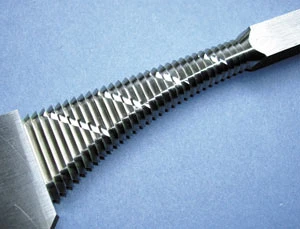
For one British company, the challenge of improving product quality and turnaround times in the demanding area of orthopedic implant and instrument manufacture has been solved by ANCA.
Corin Group, orthopedic implant manufacturers, and renowned innovators in the field, has recently installed the ANCA TX7+ CNC grinder to machine bone rasps, which are used during the surgical implantation of hip replacement devices. It will also be used to grind knee implants.
Corin Medical, founded in 1985, is based in Cirencester, in the heart of the Cotswolds in south-west England. Corin Group is committed to providing effective techniques that restore mobility and relieve the pain of osteoarthritis, and is particularly focused on providing innovative solutions for restoring quality of life for younger, active patients. Latest generation surgical instruments, together with minimally invasive systems and surgical navigation, support a wide range of orthopedic implants.
With increasing demand for their products from across the world, Corin decided to invest in a five-axis CNC grinding machine. After discussing their requirements with several companies, Corin asked ANCA to provide a solution for grinding rasps, and for machining femoral components for their knee systems, while significantly reducing current cycle times. The solution was the ANCA TX7+ machine with UGS NXCAM for post-processing output and Cimulator3D for verification.
ANCA completed two comprehensive demonstrations showcasing that the ANCA solution met the customer requirements for size tolerance, quality, surface finish and a reduction in cycle time. Corin had previously used a milling operation to produce the rasps with a cycle time of four hours per part. Using the ANCA TX7+ reduced cycle time to less than an hour with a far superior surface finish. Corin Operations Manager Richard Hemming explains the effect the TX7+ has had on their production. "The ANCA TX7+ precision CNC grinder has reduced our cycle times significantly compared with previous methods and has allowed us to reduce our lead times to days from weeks."
Generating the program in UGS NX CAM took approximately two hours for the bone rasp (shown in picture). The time required is largely dependent on the number of teeth and the contour shape. There were 48 teeth to grind which required individual sheet bodies to be modelled, ensuring that wheel position and depth would be correct all the way around the contour profile. The model of the fixture was also required to ensure wheel collision would be avoided as the wheel approached this section of the rasp.
ANCA has created several different post-processors that convert a 3D model into a program usable on the ANCA machine. Which one to use will depend upon the part geometry. For the most complex parts, a fiveaxis post can be used, taking advantage of all CNC axes on the TX7+.
A critical enhancement that has recently been added to posts is the Cutter Radius Compensation (CRC) function. Previously if there was any change to the grinding wheel dimension, due to wear, for example, the whole model had to be put through the post-processor again to generate a new program. The CRC function can now compensate for wheel wear by performing an automatic update to the program.

Explore the October 2007 Issue
Check out more from this issue and find your next story to read.
Latest from Today's Medical Developments
- Arcline to sell Medical Manufacturing Technologies to Perimeter Solutions
- Decline in German machine tool orders bottoming out
- Analysis, trends, and forecasts for the future of additive manufacturing
- BlueForge Alliance Webinar Series Part III: Integrate Nationally, Catalyze Locally
- Robot orders accelerate in Q3
- Pro Shrink TubeChiller makes shrink-fit tool holding safer, easier
- Revolutionizing biocompatibility: The role of amnion in next-generation medical devices
- #56 Lunch + Learn Podcast with Techman Robot + AMET Inc.





